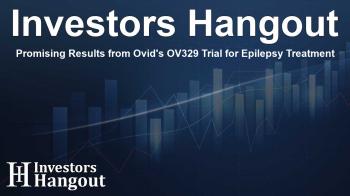Promising Results from Ovid's OV329 Trial for Epilepsy Treatment

Ovid Therapeutics Announces New Findings on OV329 for Epilepsy
An expansive biomarker study confirmed that OV329 successfully inhibited GABA-AT, showing statistically significant results across various metrics. This innovative treatment demonstrates strong inhibitory activity and could potentially offer a superior safety profile compared to existing medications.
OV329 Outshines Existing Treatments
OV329 has matched or surpassed the inhibition levels seen in vigabatrin (VGB), a first-generation GABA-AT inhibitor. Measured using transcranial magnetic stimulation (TMS), these comparisons affirm OV329’s potential as a next-generation treatment option.
Positive Pharmacological Insights
The findings also indicate that OV329 effectively penetrates the brain and engages its target, leading to biological modulation indicative of elevated GABA levels. GABA, the brain's major inhibitory neurotransmitter, plays a crucial role in reducing neuronal excitability.
Commitment to Development and Safety
Safety and tolerability results from the study suggest that OV329 is a promising candidate for further development. Its safety profile appears to be more favorable when compared to current anti-seizure medications (ASMs).
Plans for Future Studies
Ovid plans to advance OV329 into a Phase 2a study targeting drug-resistant focal onset seizures (FOS). Additionally, the company aims to complete a final enabling study to support regulatory filings for its first oral KCC2 direct activator, OV4071, anticipated in early 2026.
Encouraging Phase 1 Study Results
In the recent Phase 1 trial, OV329 was involved with 68 healthy volunteers, split into two groups: those receiving active treatment and those on placebo. The dosages ranged from 1 mg to 5 mg, with the primary objectives centered on safety, tolerability, pharmacokinetics (PK), and pharmacodynamics (PD).
Impressive GABAergic Inhibition
Results reveal that OV329 led to highly significant GABAergic inhibition. A 5 mg dose increased inhibition by 53% as measured on the APB muscle after treatment, showing significant advances compared to placebo results.
Clinical Observations on Efficacy
OV329 demonstrated comparable inhibition rates to those observed with therapeutic doses of VGB. Specifically, the study highlighted 53% inhibition in the 5 mg cohort versus the minimal 35% effect in treated groups from prior studies.
Profiling Safety and Tolerability
In terms of safety, OV329 exhibited a favorable profile in the Phase 1 trial. All reported treatment-related side effects were mild and temporary, suggesting a good tolerability spectrum for future trials.
Extensive Safety Assessments
Tests for visual changes showed no sedation or adverse events impacting visual health, demonstrating OV329's potential for a safer profile relative to existing therapies.
Exciting Prospects in Clinical Development
Ovid Therapeutics is poised to initiate a Phase 2a randomized placebo-controlled study focusing on OV329 and its effects in adult patients suffering from drug-resistant focal onset seizures. This is part of Ovid’s broader strategy for ongoing clinical advancements in its pipeline, particularly surrounding the KCC2 direct activator programs.
Future Goals in KCC2 Activator Programs
Ovid is also advancing candidates from its unique portfolio of potassium-chloride cotransporter 2 (KCC2) activators, with several regulatory and clinical milestones expected within the next year. This unique approach seeks to restore the balance between neuronal excitation and inhibition, potentially leading to better safety profiles relative to existing options.
Conference Call and Engagement
The company will host a conference call to discuss these findings, providing updates and engaging with stakeholders on the latest developments. Interested parties can participate in the webcast.
Understanding OV329 and Ovid Therapeutics
OV329 is being developed to treat rare forms of epilepsy and conditions characterized by seizures. Ovid Therapeutics Inc. specializes in creating medicines aimed at serious brain disorders, with an innovative pipeline including OV329 and novel KCC2 activators.
Frequently Asked Questions
What is OV329?
OV329 is a next-generation GABA-AT inhibitor aimed at treating drug-resistant epilepsies, targeting the underlying mechanism of neuronal hyperexcitability.
How does OV329 compare to existing treatments?
OV329 has shown stronger inhibition rates compared to first-generation GABA-AT inhibitors like vigabatrin, suggesting a potentially better therapeutic outcome for patients.
What are the next steps for Ovid Therapeutics?
Ovid plans to initiate a Phase 2a study for OV329 and further develop its KCC2 activator programs while seeking regulatory approval.
What are the safety results of OV329?
The safety profile of OV329 indicates that any side effects were mild and transient, suggesting a favorable tolerability spectrum.
How can I learn more about Ovid Therapeutics?
For more information, you can visit Ovid Therapeutics' official website, where they provide updates on their research and clinical programs.
About The Author
Contact Caleb Price privately here. Or send an email with ATTN: Caleb Price as the subject to contact@investorshangout.com.
About Investors Hangout
Investors Hangout is a leading online stock forum for financial discussion and learning, offering a wide range of free tools and resources. It draws in traders of all levels, who exchange market knowledge, investigate trading tactics, and keep an eye on industry developments in real time. Featuring financial articles, stock message boards, quotes, charts, company profiles, and live news updates. Through cooperative learning and a wealth of informational resources, it helps users from novices creating their first portfolios to experts honing their techniques. Join Investors Hangout today: https://investorshangout.com/
The content of this article is based on factual, publicly available information and does not represent legal, financial, or investment advice. Investors Hangout does not offer financial advice, and the author is not a licensed financial advisor. Consult a qualified advisor before making any financial or investment decisions based on this article. This article should not be considered advice to purchase, sell, or hold any securities or other investments. If any of the material provided here is inaccurate, please contact us for corrections.

